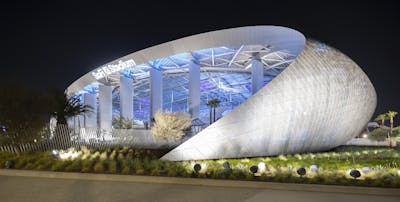
Building Design+Construction published the AIA Course on Waterproofing Deep Foundations for New Construction by Amos Chan, P.E., BECxP, CxA+BE, a project manager in Walter P Moore’s Diagnostics Group, under the the BD+C University banner—login to BDC University to take the exam.
Overview
This course covers design considerations for below-grade waterproofing for new construction, the types of below-grade systems available, and specific concerns associated with waterproofing deep foundations.
COURSE CREDIT: READ THE ARTICLE AND TAKE THE QUIZ TO EARN 1.0 AIA LU/HSW PROVIDED BY BD+C
Below-grade waterproofing systems can be critical features of building enclosure design, particularly when the structure has a deep foundation. As the foundation goes deeper, there is a greater likelihood that it will encounter the groundwater table and hydrostatic conditions, which makes choosing the right below-grade waterproofing system even more important.
When selecting and designing a below-grade waterproofing system, the primary factors to consider include the type of foundation system, the project’s site conditions, product performance properties, and construction sequencing. The design specifications for a building’s foundation are influenced by the building size and structural system, as well as the site’s soil and geological composition.
Foundation systems are typically either categorized as shallow foundations or deep foundations. Shallow foundations are used when the structural loads can be adequately distributed to a relatively shallow soil level. Examples include structural slab-on-grade foundations, footings, and grade beams. Deep foundations are used when there are more significant loads that need to be transferred to deeper soil or bedrock. These types include piles, caissons, and drilled shafts, among others.
While the structural engineer is responsible for the foundation design, the waterproofing consultant needs to understand the type of foundation used to anticipate the various interfaces and conditions the below-grade waterproofing design will need to reflect. The proximity of the foundation to the groundwater table and the potential presence of soil contaminants are critical factors to evaluate, and they can substantially influence decisions about the type of waterproofing membrane to select for the foundation elements.
To obtain a general idea of how high the groundwater table can be at the project site, one should review the geotechnical investigations report. These investigations are typically performed at the early stages of the project and can involve various subsurface and soil assessment methods, including borings. The report may document whether groundwater was encountered in any of the borings, and it may identify the historic high-water-table elevation or provide a recommended design groundwater table elevation. This elevation should be compared with the building’s foundation elevation, as well as the lowest of any foundation elements—such as the grade beam, footing, elevator pit, or sump—to ascertain whether hydrostatic conditions should be assumed for the project.
When reviewing the geotechnical investigation’s report, one should stay cognizant of the fluctuating nature of groundwater elevations and understand that the geotechnical investigations typically capture one specific moment in time. While the report can provide good insights, it does not always paint the full picture of the site’s hydrogeology. The geotechnical investigations report can also provide insight into past uses of the site and whether contaminated soils are present. For example, former gas stations and auto repair shops are likely to have petroleum or methane contaminants in the soil. Other contaminants can include acid and alkaline water, insecticides, and fertilizers.
In coastal regions, subsurface saltwater is another consideration; the presence of subsurface saltwater may warrant the use of specific versions of waterproofing membranes designed for these conditions.
When selecting the appropriate below-grade waterproofing system for the project, one should also consider the owner’s budget and what they consider to be a level of acceptable risk. This information will inform your decisions and recommendations regarding certain waterproofing product features, such as whether membranes are fully welded, adhered, or taped. Construction sequencing may influence items like backfilling and soil retention systems, and by understanding the construction project’s timeline, you can guide the selection of waterproofing products with application methods appropriate for the sequencing.


